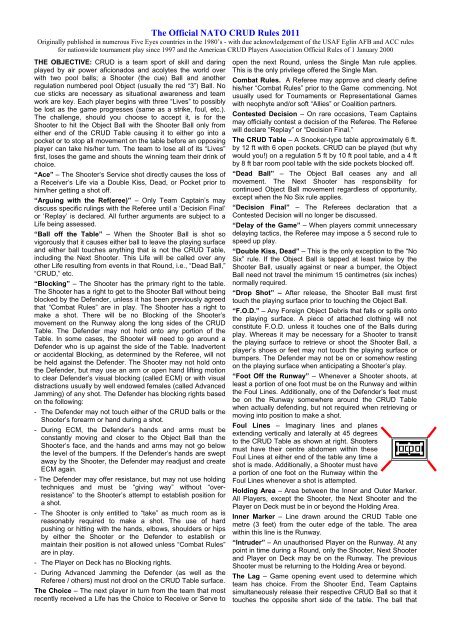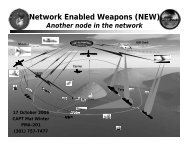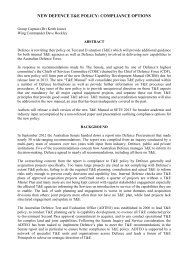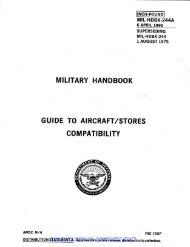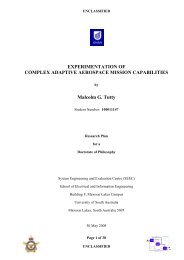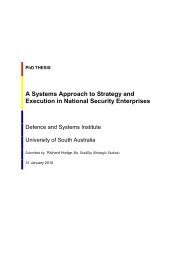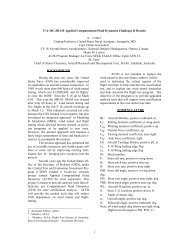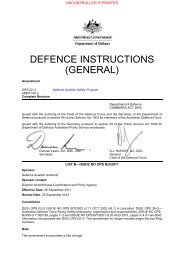NATO CRUD 2011.pdf
NATO CRUD 2011.pdf
NATO CRUD 2011.pdf
You also want an ePaper? Increase the reach of your titles
YUMPU automatically turns print PDFs into web optimized ePapers that Google loves.
The Official <strong>NATO</strong> <strong>CRUD</strong> Rules 2011<br />
Originally published in numerous Five Eyes countries in the 1980’s - with due acknowledgement of the USAF Eglin AFB and ACC rules<br />
for nationwide tournament play since 1997 and the American <strong>CRUD</strong> Players Association Official Rules of 1 January 2000<br />
THE OBJECTIVE: <strong>CRUD</strong> is a team sport of skill and daring<br />
played by air power aficionados and acolytes the world over<br />
with two pool balls; a Shooter (the cue) Ball and another<br />
regulation numbered pool Object (usually the red “3”) Ball. No<br />
cue sticks are necessary as situational awareness and team<br />
work are key. Each player begins with three “Lives” to possibly<br />
be lost as the game progresses (same as a strike, foul, etc.).<br />
The challenge, should you choose to accept it, is for the<br />
Shooter to hit the Object Ball with the Shooter Ball only from<br />
either end of the <strong>CRUD</strong> Table causing it to either go into a<br />
pocket or to stop all movement on the table before an opposing<br />
player can take his/her turn. The team to lose all of its “Lives”<br />
first, loses the game and shouts the winning team their drink of<br />
choice.<br />
“Ace” – The Shooter’s Service shot directly causes the loss of<br />
a Receiver’s Life via a Double Kiss, Dead, or Pocket prior to<br />
him/her getting a shot off.<br />
“Arguing with the Ref(eree)” – Only Team Captain’s may<br />
discuss specific rulings with the Referee until a ‘Decision Final’<br />
or ‘Replay’ is declared. All further arguments are subject to a<br />
Life being assessed.<br />
“Ball off the Table” – When the Shooter Ball is shot so<br />
vigorously that it causes either ball to leave the playing surface<br />
and either ball touches anything that is not the <strong>CRUD</strong> Table,<br />
including the Next Shooter. This Life will be called over any<br />
other Life resulting from events in that Round, i.e., “Dead Ball,”<br />
“<strong>CRUD</strong>,” etc.<br />
“Blocking” – The Shooter has the primary right to the table.<br />
The Shooter has a right to get to the Shooter Ball without being<br />
blocked by the Defender, unless it has been previously agreed<br />
that “Combat Rules” are in play. The Shooter has a right to<br />
make a shot. There will be no Blocking of the Shooter’s<br />
movement on the Runway along the long sides of the <strong>CRUD</strong><br />
Table. The Defender may not hold onto any portion of the<br />
Table. In some cases, the Shooter will need to go around a<br />
Defender who is up against the side of the Table. Inadvertent<br />
or accidental Blocking, as determined by the Referee, will not<br />
be held against the Defender. The Shooter may not hold onto<br />
the Defender, but may use an arm or open hand lifting motion<br />
to clear Defender’s visual blocking (called ECM) or with visual<br />
distractions usually by well endowed females (called Advanced<br />
Jamming) of any shot. The Defender has blocking rights based<br />
on the following:<br />
- The Defender may not touch either of the <strong>CRUD</strong> balls or the<br />
Shooter’s forearm or hand during a shot.<br />
- During ECM, the Defender’s hands and arms must be<br />
constantly moving and closer to the Object Ball than the<br />
Shooter’s face, and the hands and arms may not go below<br />
the level of the bumpers. If the Defender’s hands are swept<br />
away by the Shooter, the Defender may readjust and create<br />
ECM again.<br />
- The Defender may offer resistance, but may not use holding<br />
techniques and must be “giving way” without “overresistance”<br />
to the Shooter’s attempt to establish position for<br />
a shot.<br />
- The Shooter is only entitled to “take” as much room as is<br />
reasonably required to make a shot. The use of hard<br />
pushing or hitting with the hands, elbows, shoulders or hips<br />
by either the Shooter or the Defender to establish or<br />
maintain their position is not allowed unless “Combat Rules”<br />
are in play.<br />
- The Player on Deck has no Blocking rights.<br />
- During Advanced Jamming the Defender (as well as the<br />
Referee / others) must not drool on the <strong>CRUD</strong> Table surface.<br />
The Choice – The next player in turn from the team that most<br />
recently received a Life has the Choice to Receive or Serve to<br />
open the next Round, unless the Single Man rule applies.<br />
This is the only privilege offered the Single Man.<br />
Combat Rules. A Referee may approve and clearly define<br />
his/her “Combat Rules” prior to the Game commencing. Not<br />
usually used for Tournaments or Representational Games<br />
with neophyte and/or soft “Allies” or Coalition partners.<br />
Contested Decision – On rare occasions, Team Captains<br />
may officially contest a decision of the Referee. The Referee<br />
will declare “Replay” or “Decision Final.”<br />
The <strong>CRUD</strong> Table – A Snooker-type table approximately 6 ft.<br />
by 12 ft with 6 open pockets. <strong>CRUD</strong> can be played (but why<br />
would you!) on a regulation 5 ft by 10 ft pool table, and a 4 ft<br />
by 8 ft bar room pool table with the side pockets blocked off.<br />
“Dead Ball” – The Object Ball ceases any and all<br />
movement. The Next Shooter has responsibility for<br />
continued Object Ball movement regardless of opportunity,<br />
except when the No Six rule applies.<br />
“Decision Final” – The Referees declaration that a<br />
Contested Decision will no longer be discussed.<br />
“Delay of the Game” – When players commit unnecessary<br />
delaying tactics, the Referee may impose a 5 second rule to<br />
speed up play.<br />
“Double Kiss, Dead” – This is the only exception to the “No<br />
Six” rule. If the Object Ball is tapped at least twice by the<br />
Shooter Ball, usually against or near a bumper, the Object<br />
Ball need not travel the minimum 15 centimetres (six inches)<br />
normally required.<br />
“Drop Shot” – After release, the Shooter Ball must first<br />
touch the playing surface prior to touching the Object Ball.<br />
“F.O.D.” – Any Foreign Object Debris that falls or spills onto<br />
the playing surface. A piece of attached clothing will not<br />
constitute F.O.D. unless it touches one of the Balls during<br />
play. Whereas it may be necessary for a Shooter to transit<br />
the playing surface to retrieve or shoot the Shooter Ball, a<br />
player’s shoes or feet may not touch the playing surface or<br />
bumpers. The Defender may not be on or somehow resting<br />
on the playing surface when anticipating a Shooter’s play.<br />
“Foot Off the Runway” – Whenever a Shooter shoots, at<br />
least a portion of one foot must be on the Runway and within<br />
the Foul Lines. Additionally, one of the Defender’s feet must<br />
be on the Runway somewhere around the <strong>CRUD</strong> Table<br />
when actually defending, but not required when retrieving or<br />
moving into position to make a shot.<br />
Foul Lines – Imaginary lines and planes<br />
extending vertically and laterally at 45 degrees<br />
to the <strong>CRUD</strong> Table as shown at right. Shooters<br />
must have their centre abdomen within these<br />
Foul Lines at either end of the table any time a<br />
shot is made. Additionally, a Shooter must have<br />
a portion of one foot on the Runway within the<br />
Foul Lines whenever a shot is attempted.<br />
Holding Area – Area between the Inner and Outer Marker.<br />
All Players, except the Shooter, the Next Shooter and the<br />
Player on Deck must be in or beyond the Holding Area.<br />
Inner Marker – Line drawn around the <strong>CRUD</strong> Table one<br />
metre (3 feet) from the outer edge of the table. The area<br />
within this line is the Runway.<br />
“Intruder” – An unauthorised Player on the Runway. At any<br />
point in time during a Round, only the Shooter, Next Shooter<br />
and Player on Deck may be on the Runway. The previous<br />
Shooter must be returning to the Holding Area or beyond.<br />
The Lag – Game opening event used to determine which<br />
team has choice. From the Shooter End, Team Captains<br />
simultaneously release their respective <strong>CRUD</strong> Ball so that it<br />
touches the opposite short side of the table. The ball that
eturns closest to the Shooter end without touching it or the<br />
side rails determines Choice.<br />
The Life – The term used to impose any infraction of these<br />
rules. The Life may also be called by its proper name.<br />
Infractions in “quotation marks” within these rules are Lives.<br />
“No Six” – The Shooter must personally make this call to stop<br />
the Round before taking any shot. Whenever the Object Ball is<br />
hit, it must travel 15 Centimetres (6 inches), including bumper<br />
bounce, except in the cases of the “Double Kiss, Dead." The<br />
Referee will determine the distance of travel based on his<br />
judgment of where the Object Ball was last hit. If full travel is<br />
less than 15 Centimetres (6 inches), centre-ball to centre-ball,<br />
the Life is against the last Shooter. If it travelled 15<br />
Centimetres (6 inches) or more, the Life is a Dead Ball on the<br />
Ball-in-Hand Player.<br />
The Object Ball – The Object Ball may only be touched by the<br />
Shooter Ball, and must be Pocketed or kept in motion at all<br />
times during a Round.<br />
Outer Marker – Boundary line one metre (3 feet) beyond the<br />
Inner Marker. The area between the Inner and the Outer<br />
Marker is the Holding Area where players stand awaiting their<br />
next play.<br />
Player on Deck – This player, as the next player in turn to<br />
play, is allowed on the Runway, but has no Blocking rights.<br />
“Playing Out of Turn” – A Player touching the Shooter Ball<br />
when it is not that player’s turn or any out-of-turn play detected<br />
by the Judge. Also, a Team Captain may stop a game to point<br />
this infraction out to the Referee at the risk of a Life. If verified,<br />
a Life will be assessed against the guilty Team’s Captain or its<br />
first available player. Otherwise, a Life will be assessed for<br />
stopping the Round.<br />
“Pocket” – Any time the Object Ball is hit into, and remains in,<br />
one of the pockets, i.e., centre-ball past the lip of the pocket.<br />
The Referee will determine who receives the Life based on the<br />
Judge’s opinion of whether or not the Next Shooter had ANY<br />
opportunity to influence the play with a valid shot. If the Next<br />
Shooter had a chance to influence play, the next Shooter<br />
receives the Life. Otherwise, the Life is against the previous<br />
Shooter on that team.<br />
“Push Shot” – Any stylised propelling of the Shooter Ball by<br />
the Shooter’s hand is allowed, providing the Shooter’s hands<br />
or fingers are not touching the Shooter Ball when or after the<br />
Shooter Ball makes contact with the Object Ball.<br />
The Receiver / Next Shooter —The Defender as a Round<br />
begins, and the next player after the Shooter at any point in<br />
time.<br />
The Referee –- a respected and experienced (if much<br />
maligned) character whose word is law, or it’s a Life too.<br />
“Replay” – If “Replay” is declared following a Contested<br />
Decision, teams start from the beginning of the Round in<br />
question, or if the Referee allows, Team Captains or<br />
designated Players may face off one-on-one. Choice goes to<br />
the Team that had it at the start of the Round in question.<br />
“Roughing the Referee” – No Player may make contact with<br />
or bump into the Referee so as to cause him/her the need to<br />
regain balance, composure or heaven forbid spill his drink.<br />
Round – Begins with the Service shot and ends when a Life is<br />
called, or the play is stopped for any reason.<br />
Runway – An area one metre (3 feet) wide around the <strong>CRUD</strong><br />
Table. Only the Shooter, Next Shooter, and the Player on Deck<br />
may be on the Runway at any one time. The (previous)<br />
Shooters must, without Blocking the (next) Shooter, depart the<br />
runway as quickly as possible after making their shot, except in<br />
the case where they are the Single Man.<br />
“Scratch” – During Service, the Server misses the spotted<br />
Object Ball three (3) times.<br />
The Service – The opening event of each Round. With the<br />
Object Ball spotted on the centre line 15 centimetres (6 inches)<br />
from the Receiver end of the table (typically halfway to the<br />
Snooker location spot), the Shooter is given three (3) attempts<br />
to hit the spotted Object Ball using any number of bumper<br />
bounces. Shooter Ball movement may only be stopped by the<br />
Referee or the Shooter. Any Service where the Shooter Ball<br />
goes beyond half the length of the Table will be counted as<br />
one (1) attempt.<br />
The Shooter – The Offender as a Round begins and the<br />
player with the responsibility to make the next shot before<br />
the Object Ball is called Dead or is Pocketed.<br />
The Shooter Ball – This ball, usually a cue ball, may be<br />
touched or picked up by the Receiver/Next Shooter from<br />
anywhere around the table only after it hits the Object Ball.<br />
However, it must be shot in accordance with all applicable<br />
rules herein. The Shooter may, in order to hit an Object Ball<br />
still in motion, recover the Shooter Ball - even if it goes into a<br />
pocket-- and take as many ‘shots’ as needed. All shots must<br />
be at the Object Ball and not at other Players. Accidental<br />
release or dropping of the Shooter Ball will not be held<br />
against the Shooter, unless it hits the Object Ball.<br />
The Single Man – When a Team is attrited down to one<br />
Player (of any sex), that Player has the Choice at the<br />
beginning of each Round to Receive or Serve. When both<br />
teams have only one player remaining, normal Choice rules<br />
apply. NOTE: All Blocking rules remaining in effect for<br />
Tournament Games.<br />
Substitution – Substitution may not be made without the<br />
consent of the Referee.<br />
“Unsportsmanlike Conduct” – When the Referee<br />
determines a player’s actions or language is unsuitable for<br />
the game at hand, the Referee may assess a Life or eject a<br />
player from the game or tournament.<br />
The Warning – If, in the Referee’s considered judgement, a<br />
Player makes a play that is very nearly a Life and the<br />
Referee might be inclined to assess a Life if that same play<br />
or event is committed again, the Referee may call “Warning<br />
on the Push, Blocking, etc.”<br />
“Wrong Ball” – During play, the Shooter touches the Object<br />
Ball.<br />
Traditional Concepts & Conventions:<br />
1. The losing team buys the winning team their drink of<br />
choice, usually by aligned players on the scoreboard. If the<br />
winning team has at least one “Virgin” (no Lives assessed),<br />
the Virgin’s team is entitled to two drinks of choice for that<br />
game by the losers.<br />
2. As recompense for services rendered, the first player<br />
attrited from the game buys the Referee his or her drink of<br />
choice. The next player attrited buys a drink for the<br />
Scorekeeper<br />
3. The 15 centimetre (6 inch) rule is measured by a<br />
Canadian/Australian dollar bill, now both extinct. An<br />
American dollar or a Canadian two dollar bill may be used.<br />
4. To even the number of players on a team, one team may<br />
use one or more “Ghost(s).” The Team’s Ghost receives the<br />
first three available Lives that are not any Player’s first Life,<br />
or any other agreed-upon method.<br />
5. The original <strong>CRUD</strong> Foul Line was typically a 45 degree<br />
imaginary line extending outward from each corner. <strong>NATO</strong><br />
has selected this as a more interoperable foul line to liven up<br />
the <strong>CRUD</strong> rules and make future <strong>CRUD</strong> an even more free<br />
flowing game.<br />
6. For violations of the Foul Line rules, the Referee may use<br />
the term “Balls” or “Lips”, as appropriate.<br />
7. Some 6’x12’ Snooker tables have been built without side<br />
pockets. Plugging the side pockets of <strong>CRUD</strong> Tables smaller<br />
than 6' by 12' Snooker tables is traditionally done with rolls of<br />
toilet paper. True <strong>CRUD</strong> aficionados and acolytes always<br />
use all six pockets on the 6’x12’ Snooker table.<br />
8. A Player who actually reads all these rules to try and win a<br />
point with the Referee may be assessed a Life or be obliged<br />
to buy the Referee a drink of his/her choice.<br />
Comments to <strong>NATO</strong><strong>CRUD</strong>RULES@hotmail.com<br />
See www.maltutty.com using visitor / Maven1<br />
Wing Commander Malcolm G. “Maven” Tutty, RAAF


